Financial Accounting: A Comprehensive Guide to Bookkeeping, Financial Statements, and Bank Reconciliation
VerifiedAdded on 2024/06/03
|19
|3448
|463
AI Summary
This comprehensive guide delves into the fundamentals of financial accounting, covering essential concepts like double-entry bookkeeping, recording sales and purchase transactions, preparing trial balances, and generating final accounts. It explores adjustments for accruals, depreciation, and prepayments, and provides practical examples for sole-traders, partnerships, and limited companies. The guide also examines the bank reconciliation process, explaining how to identify and reconcile variances, and discusses the role of control and suspense accounts in maintaining accurate financial records. This resource is ideal for students and professionals seeking a thorough understanding of financial accounting principles and practices.
Contribute Materials
Your contribution can guide someone’s learning journey. Share your
documents today.
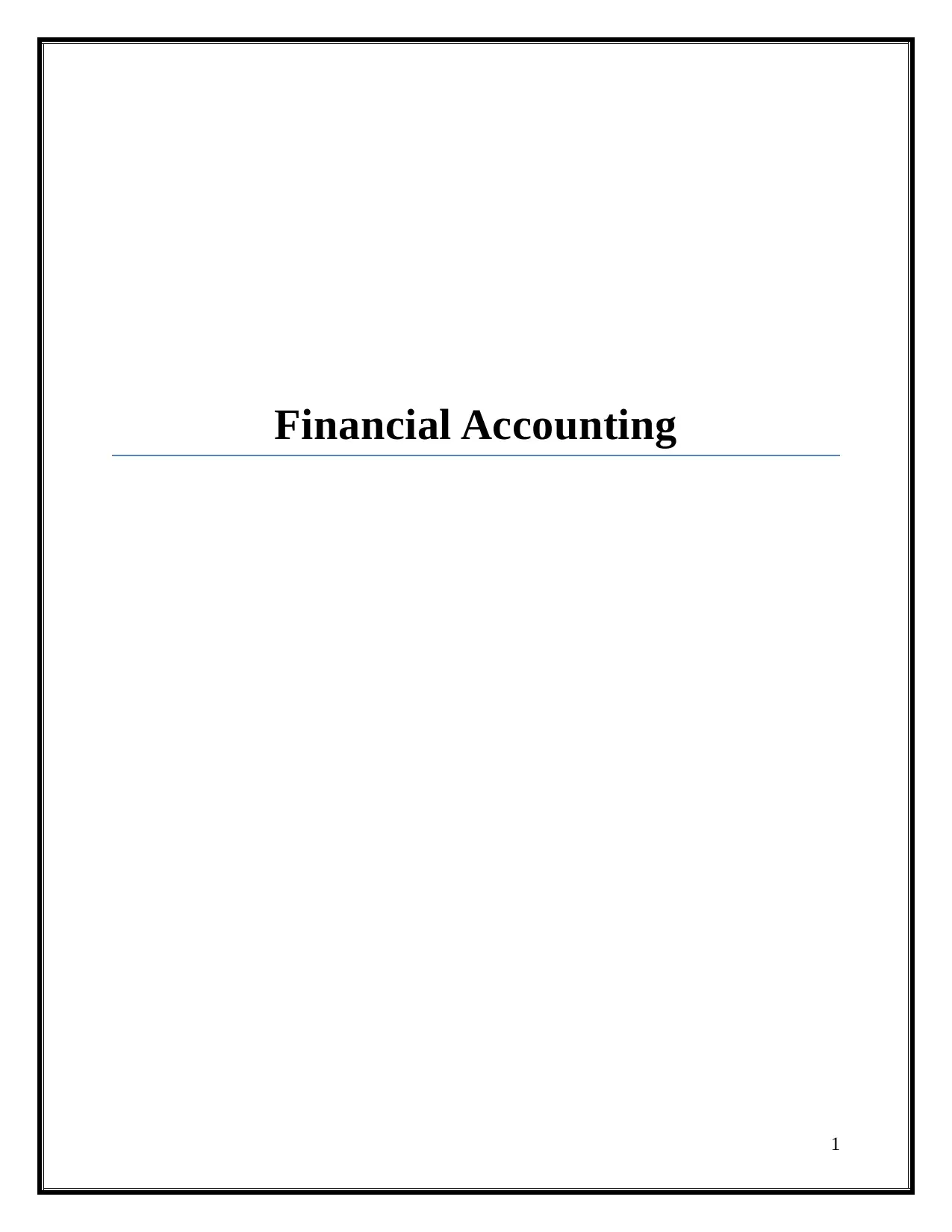
Financial Accounting
1
1
Secure Best Marks with AI Grader
Need help grading? Try our AI Grader for instant feedback on your assignments.
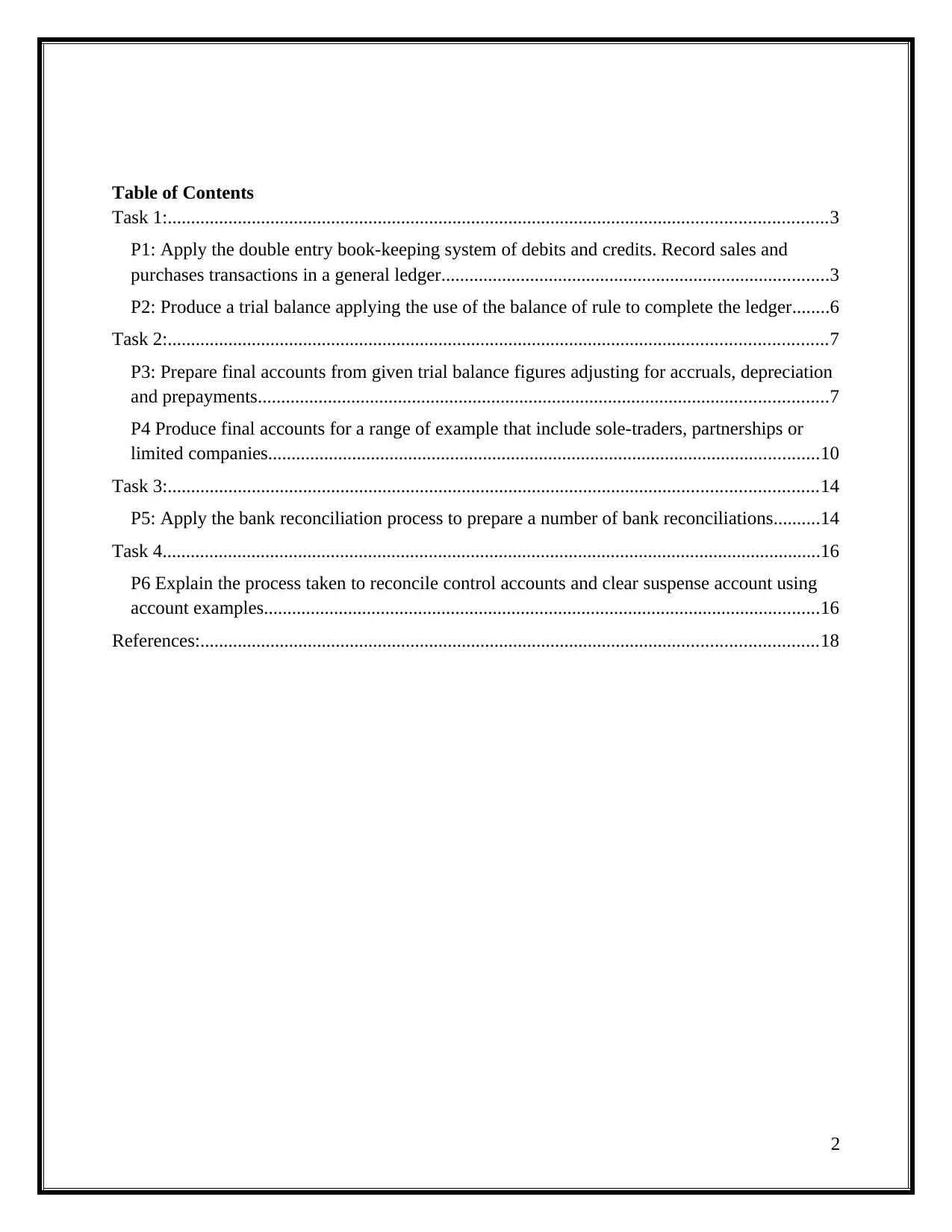
Table of Contents
Task 1:.............................................................................................................................................3
P1: Apply the double entry book-keeping system of debits and credits. Record sales and
purchases transactions in a general ledger...................................................................................3
P2: Produce a trial balance applying the use of the balance of rule to complete the ledger........6
Task 2:.............................................................................................................................................7
P3: Prepare final accounts from given trial balance figures adjusting for accruals, depreciation
and prepayments..........................................................................................................................7
P4 Produce final accounts for a range of example that include sole-traders, partnerships or
limited companies......................................................................................................................10
Task 3:...........................................................................................................................................14
P5: Apply the bank reconciliation process to prepare a number of bank reconciliations..........14
Task 4.............................................................................................................................................16
P6 Explain the process taken to reconcile control accounts and clear suspense account using
account examples.......................................................................................................................16
References:....................................................................................................................................18
2
Task 1:.............................................................................................................................................3
P1: Apply the double entry book-keeping system of debits and credits. Record sales and
purchases transactions in a general ledger...................................................................................3
P2: Produce a trial balance applying the use of the balance of rule to complete the ledger........6
Task 2:.............................................................................................................................................7
P3: Prepare final accounts from given trial balance figures adjusting for accruals, depreciation
and prepayments..........................................................................................................................7
P4 Produce final accounts for a range of example that include sole-traders, partnerships or
limited companies......................................................................................................................10
Task 3:...........................................................................................................................................14
P5: Apply the bank reconciliation process to prepare a number of bank reconciliations..........14
Task 4.............................................................................................................................................16
P6 Explain the process taken to reconcile control accounts and clear suspense account using
account examples.......................................................................................................................16
References:....................................................................................................................................18
2

Task 1:
P1: Apply the double entry book-keeping system of debits and credits. Record sales and
purchases transactions in a general ledger
Business transaction: Any transactions in the business which is related to the accounting terms
such as income, expense, assets and capital. An event or an activity which is measured in
monetary terms and performs the functions and operates the business entity is known as a
business transaction. The business transaction shows the financial position of the company.
Types of a business transaction
Each transaction of a company is recorded in a journal entry by a source document.
Sales transaction: The transactions related to sales can be based on the cash, credit and advance
payment sale. It is an agreement between the two party’s buyer and seller, where the buyer
receives the goods and services on the security of a price. The sales transaction is credited in the
business while the cash is debited.
Purchase transaction: Purchase transactions are those transactions in which the cash is paid for
taking an acquisition of the asset. Purchase transactions include both cash and credit purchases.
Purchase transactions are debited in the business while the cash is credited.
Receipts transaction: This transaction is recorded in the business when the items are received
from the suppliers against our purchase order. The accounting of cash receipts is done as by
debiting the cash or the asset which is increasing.
Payment transaction: In this type of transaction the payment is made to customers, clients and
consumer in monetary terms. In payment account, the cash is credited. A payment is a
transaction in which the consumer pays the bills or deposits the money.
Regulations apply to financial accounting
The GAAP is followed for the accounting rules and regulation for financial reporting. GAAP is
used by the organisation to record the accounting information. It summarises the accounting
records into the financial statement. GAAP also helps in business by comparing the different
financial records such as assets, liabilities, equity, revenues, expenses, etc. Different accounting
standards have been adopted by the company for the proper recording of the financial records.
IFRS is also an accounting standard which helps the companies in disclosing the financial
statements.
Double entry and book keeping:
3
P1: Apply the double entry book-keeping system of debits and credits. Record sales and
purchases transactions in a general ledger
Business transaction: Any transactions in the business which is related to the accounting terms
such as income, expense, assets and capital. An event or an activity which is measured in
monetary terms and performs the functions and operates the business entity is known as a
business transaction. The business transaction shows the financial position of the company.
Types of a business transaction
Each transaction of a company is recorded in a journal entry by a source document.
Sales transaction: The transactions related to sales can be based on the cash, credit and advance
payment sale. It is an agreement between the two party’s buyer and seller, where the buyer
receives the goods and services on the security of a price. The sales transaction is credited in the
business while the cash is debited.
Purchase transaction: Purchase transactions are those transactions in which the cash is paid for
taking an acquisition of the asset. Purchase transactions include both cash and credit purchases.
Purchase transactions are debited in the business while the cash is credited.
Receipts transaction: This transaction is recorded in the business when the items are received
from the suppliers against our purchase order. The accounting of cash receipts is done as by
debiting the cash or the asset which is increasing.
Payment transaction: In this type of transaction the payment is made to customers, clients and
consumer in monetary terms. In payment account, the cash is credited. A payment is a
transaction in which the consumer pays the bills or deposits the money.
Regulations apply to financial accounting
The GAAP is followed for the accounting rules and regulation for financial reporting. GAAP is
used by the organisation to record the accounting information. It summarises the accounting
records into the financial statement. GAAP also helps in business by comparing the different
financial records such as assets, liabilities, equity, revenues, expenses, etc. Different accounting
standards have been adopted by the company for the proper recording of the financial records.
IFRS is also an accounting standard which helps the companies in disclosing the financial
statements.
Double entry and book keeping:
3
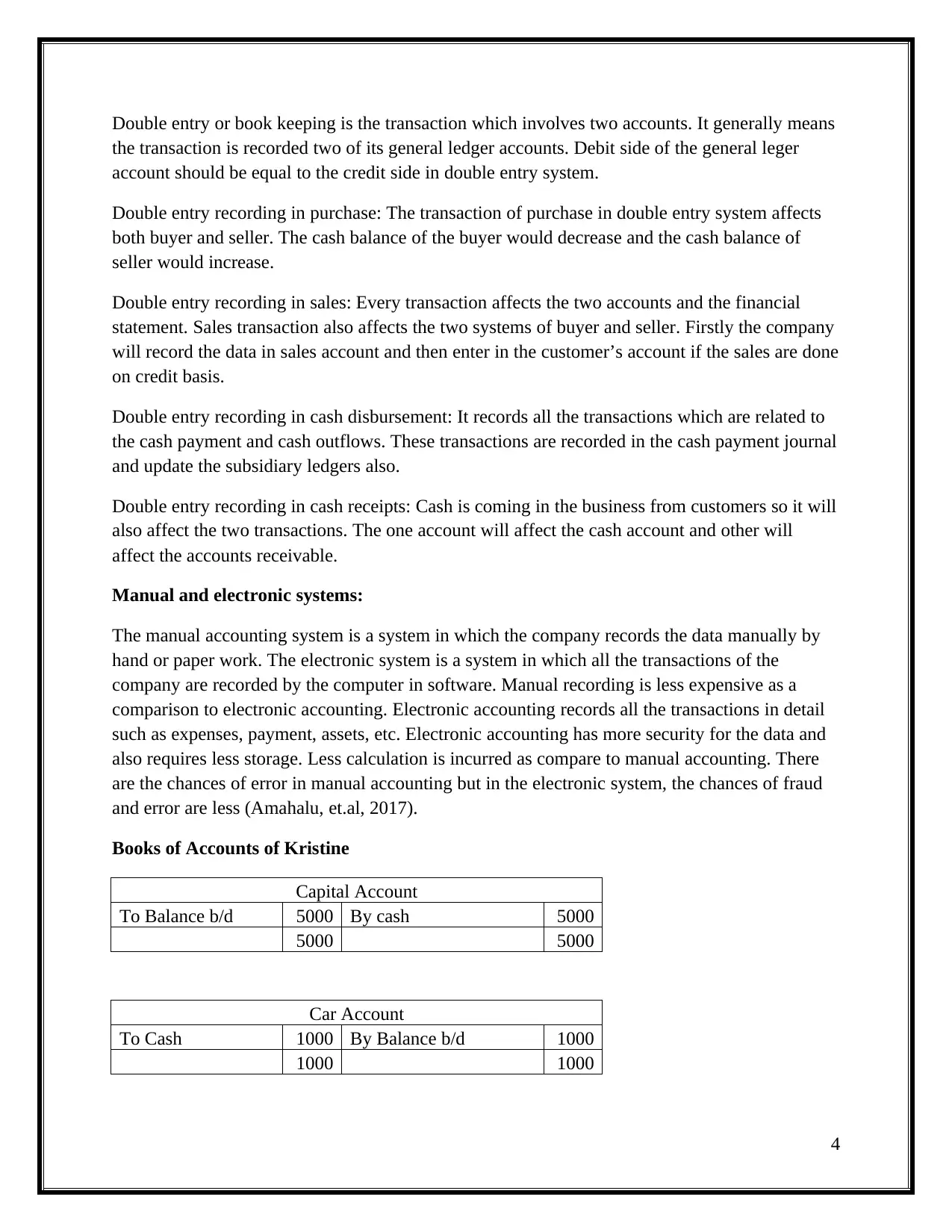
Double entry or book keeping is the transaction which involves two accounts. It generally means
the transaction is recorded two of its general ledger accounts. Debit side of the general leger
account should be equal to the credit side in double entry system.
Double entry recording in purchase: The transaction of purchase in double entry system affects
both buyer and seller. The cash balance of the buyer would decrease and the cash balance of
seller would increase.
Double entry recording in sales: Every transaction affects the two accounts and the financial
statement. Sales transaction also affects the two systems of buyer and seller. Firstly the company
will record the data in sales account and then enter in the customer’s account if the sales are done
on credit basis.
Double entry recording in cash disbursement: It records all the transactions which are related to
the cash payment and cash outflows. These transactions are recorded in the cash payment journal
and update the subsidiary ledgers also.
Double entry recording in cash receipts: Cash is coming in the business from customers so it will
also affect the two transactions. The one account will affect the cash account and other will
affect the accounts receivable.
Manual and electronic systems:
The manual accounting system is a system in which the company records the data manually by
hand or paper work. The electronic system is a system in which all the transactions of the
company are recorded by the computer in software. Manual recording is less expensive as a
comparison to electronic accounting. Electronic accounting records all the transactions in detail
such as expenses, payment, assets, etc. Electronic accounting has more security for the data and
also requires less storage. Less calculation is incurred as compare to manual accounting. There
are the chances of error in manual accounting but in the electronic system, the chances of fraud
and error are less (Amahalu, et.al, 2017).
Books of Accounts of Kristine
Capital Account
To Balance b/d 5000 By cash 5000
5000 5000
Car Account
To Cash 1000 By Balance b/d 1000
1000 1000
4
the transaction is recorded two of its general ledger accounts. Debit side of the general leger
account should be equal to the credit side in double entry system.
Double entry recording in purchase: The transaction of purchase in double entry system affects
both buyer and seller. The cash balance of the buyer would decrease and the cash balance of
seller would increase.
Double entry recording in sales: Every transaction affects the two accounts and the financial
statement. Sales transaction also affects the two systems of buyer and seller. Firstly the company
will record the data in sales account and then enter in the customer’s account if the sales are done
on credit basis.
Double entry recording in cash disbursement: It records all the transactions which are related to
the cash payment and cash outflows. These transactions are recorded in the cash payment journal
and update the subsidiary ledgers also.
Double entry recording in cash receipts: Cash is coming in the business from customers so it will
also affect the two transactions. The one account will affect the cash account and other will
affect the accounts receivable.
Manual and electronic systems:
The manual accounting system is a system in which the company records the data manually by
hand or paper work. The electronic system is a system in which all the transactions of the
company are recorded by the computer in software. Manual recording is less expensive as a
comparison to electronic accounting. Electronic accounting records all the transactions in detail
such as expenses, payment, assets, etc. Electronic accounting has more security for the data and
also requires less storage. Less calculation is incurred as compare to manual accounting. There
are the chances of error in manual accounting but in the electronic system, the chances of fraud
and error are less (Amahalu, et.al, 2017).
Books of Accounts of Kristine
Capital Account
To Balance b/d 5000 By cash 5000
5000 5000
Car Account
To Cash 1000 By Balance b/d 1000
1000 1000
4
Secure Best Marks with AI Grader
Need help grading? Try our AI Grader for instant feedback on your assignments.
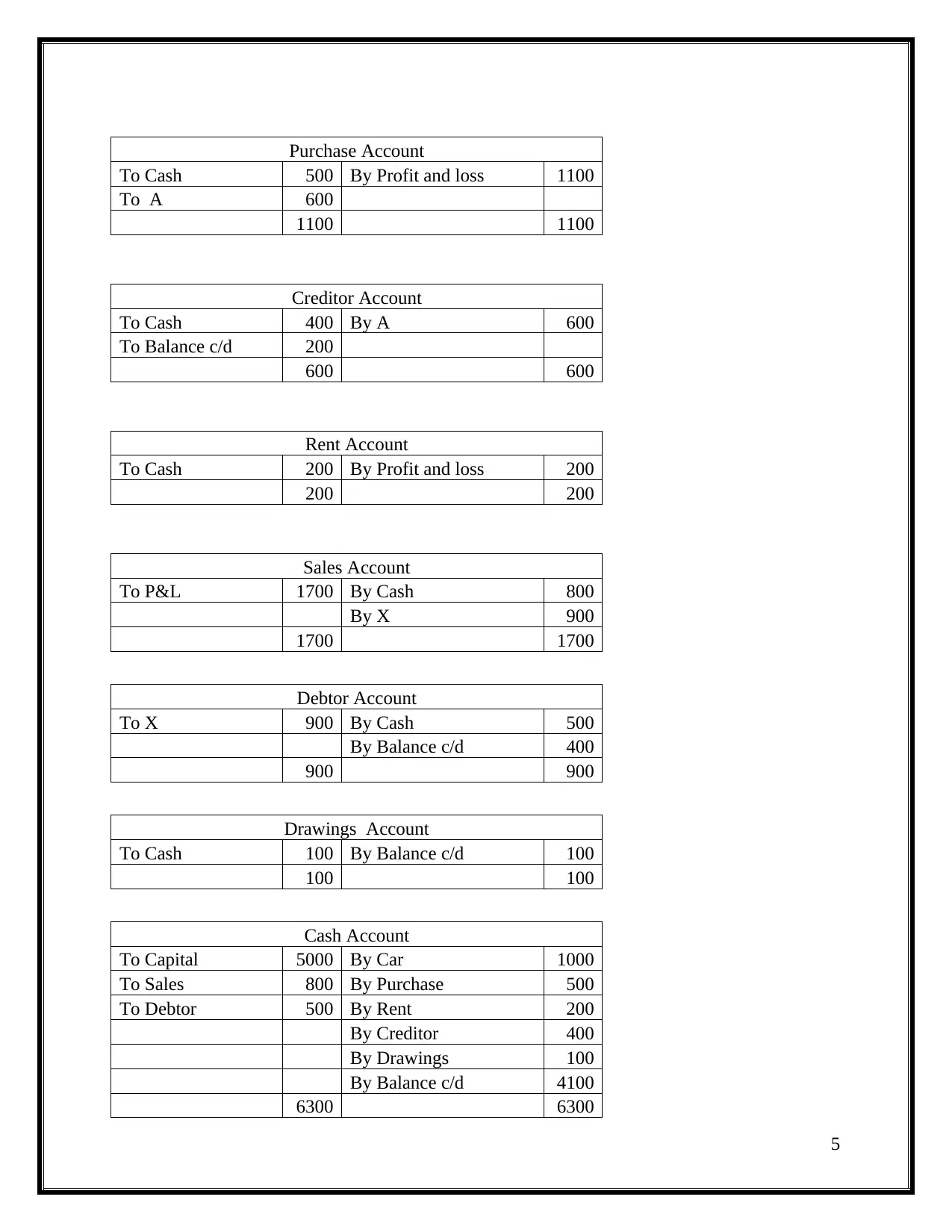
Purchase Account
To Cash 500 By Profit and loss 1100
To A 600
1100 1100
Creditor Account
To Cash 400 By A 600
To Balance c/d 200
600 600
Rent Account
To Cash 200 By Profit and loss 200
200 200
Sales Account
To P&L 1700 By Cash 800
By X 900
1700 1700
Debtor Account
To X 900 By Cash 500
By Balance c/d 400
900 900
Drawings Account
To Cash 100 By Balance c/d 100
100 100
Cash Account
To Capital 5000 By Car 1000
To Sales 800 By Purchase 500
To Debtor 500 By Rent 200
By Creditor 400
By Drawings 100
By Balance c/d 4100
6300 6300
5
To Cash 500 By Profit and loss 1100
To A 600
1100 1100
Creditor Account
To Cash 400 By A 600
To Balance c/d 200
600 600
Rent Account
To Cash 200 By Profit and loss 200
200 200
Sales Account
To P&L 1700 By Cash 800
By X 900
1700 1700
Debtor Account
To X 900 By Cash 500
By Balance c/d 400
900 900
Drawings Account
To Cash 100 By Balance c/d 100
100 100
Cash Account
To Capital 5000 By Car 1000
To Sales 800 By Purchase 500
To Debtor 500 By Rent 200
By Creditor 400
By Drawings 100
By Balance c/d 4100
6300 6300
5
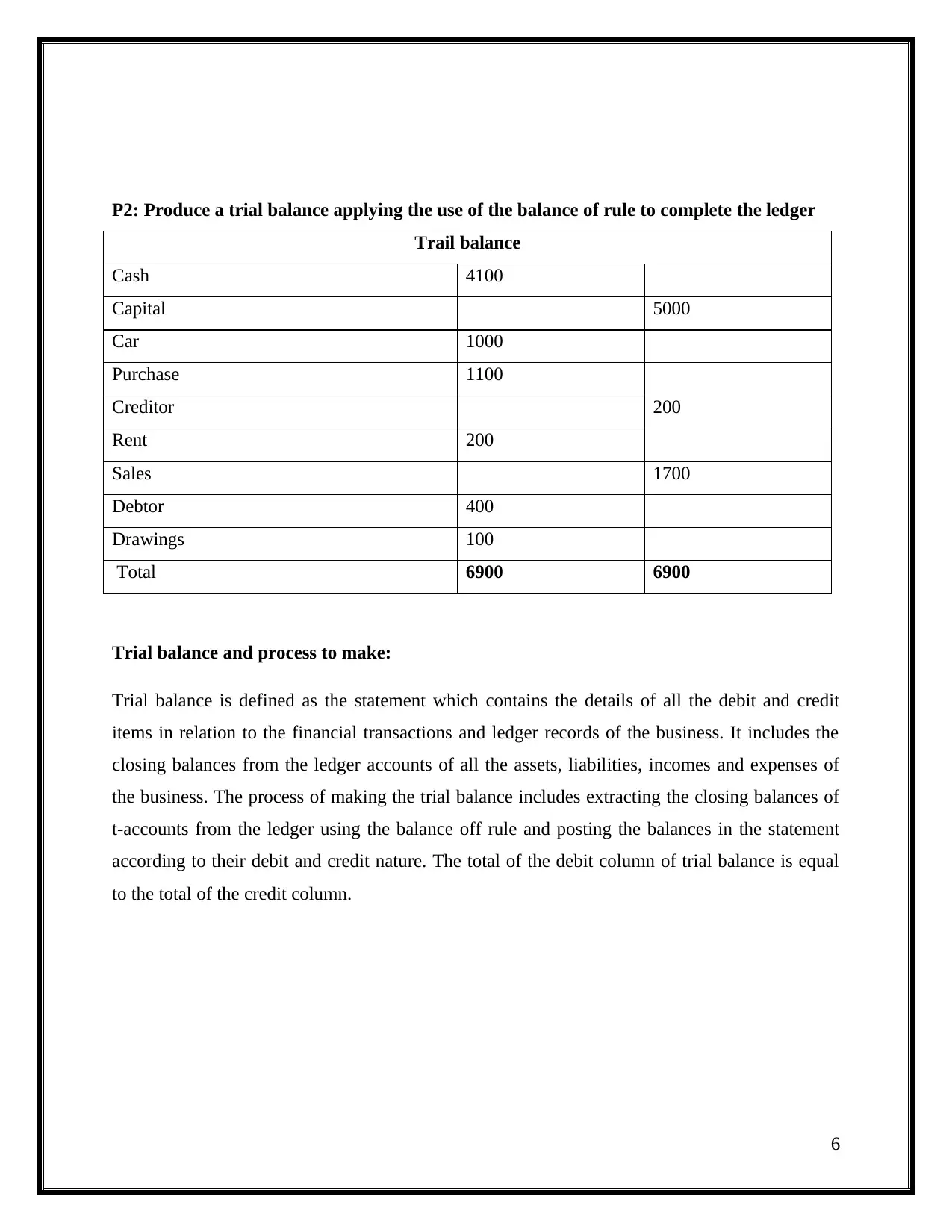
P2: Produce a trial balance applying the use of the balance of rule to complete the ledger
Trail balance
Cash 4100
Capital 5000
Car 1000
Purchase 1100
Creditor 200
Rent 200
Sales 1700
Debtor 400
Drawings 100
Total 6900 6900
Trial balance and process to make:
Trial balance is defined as the statement which contains the details of all the debit and credit
items in relation to the financial transactions and ledger records of the business. It includes the
closing balances from the ledger accounts of all the assets, liabilities, incomes and expenses of
the business. The process of making the trial balance includes extracting the closing balances of
t-accounts from the ledger using the balance off rule and posting the balances in the statement
according to their debit and credit nature. The total of the debit column of trial balance is equal
to the total of the credit column.
6
Trail balance
Cash 4100
Capital 5000
Car 1000
Purchase 1100
Creditor 200
Rent 200
Sales 1700
Debtor 400
Drawings 100
Total 6900 6900
Trial balance and process to make:
Trial balance is defined as the statement which contains the details of all the debit and credit
items in relation to the financial transactions and ledger records of the business. It includes the
closing balances from the ledger accounts of all the assets, liabilities, incomes and expenses of
the business. The process of making the trial balance includes extracting the closing balances of
t-accounts from the ledger using the balance off rule and posting the balances in the statement
according to their debit and credit nature. The total of the debit column of trial balance is equal
to the total of the credit column.
6
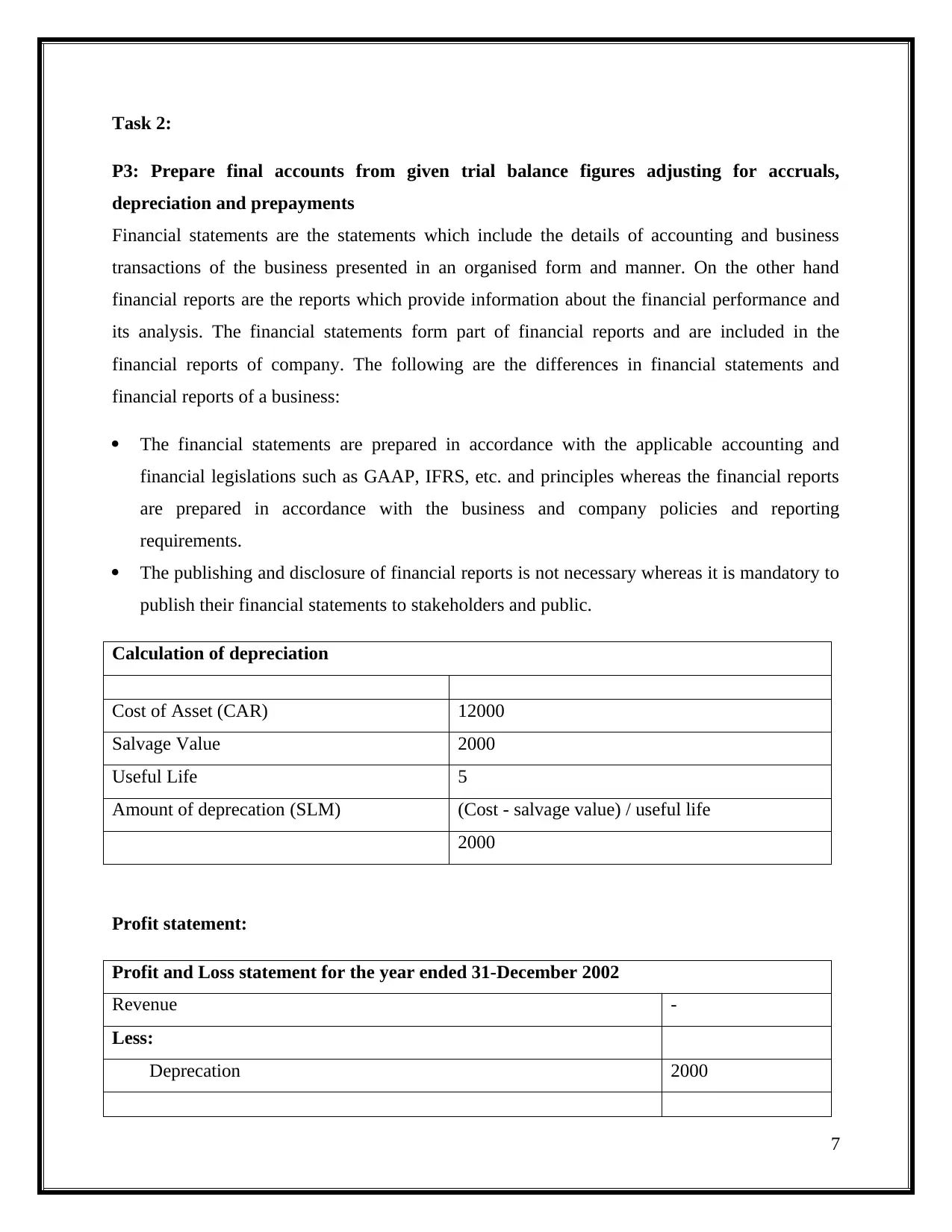
Task 2:
P3: Prepare final accounts from given trial balance figures adjusting for accruals,
depreciation and prepayments
Financial statements are the statements which include the details of accounting and business
transactions of the business presented in an organised form and manner. On the other hand
financial reports are the reports which provide information about the financial performance and
its analysis. The financial statements form part of financial reports and are included in the
financial reports of company. The following are the differences in financial statements and
financial reports of a business:
The financial statements are prepared in accordance with the applicable accounting and
financial legislations such as GAAP, IFRS, etc. and principles whereas the financial reports
are prepared in accordance with the business and company policies and reporting
requirements.
The publishing and disclosure of financial reports is not necessary whereas it is mandatory to
publish their financial statements to stakeholders and public.
Calculation of depreciation
Cost of Asset (CAR) 12000
Salvage Value 2000
Useful Life 5
Amount of deprecation (SLM) (Cost - salvage value) / useful life
2000
Profit statement:
Profit and Loss statement for the year ended 31-December 2002
Revenue -
Less:
Deprecation 2000
7
P3: Prepare final accounts from given trial balance figures adjusting for accruals,
depreciation and prepayments
Financial statements are the statements which include the details of accounting and business
transactions of the business presented in an organised form and manner. On the other hand
financial reports are the reports which provide information about the financial performance and
its analysis. The financial statements form part of financial reports and are included in the
financial reports of company. The following are the differences in financial statements and
financial reports of a business:
The financial statements are prepared in accordance with the applicable accounting and
financial legislations such as GAAP, IFRS, etc. and principles whereas the financial reports
are prepared in accordance with the business and company policies and reporting
requirements.
The publishing and disclosure of financial reports is not necessary whereas it is mandatory to
publish their financial statements to stakeholders and public.
Calculation of depreciation
Cost of Asset (CAR) 12000
Salvage Value 2000
Useful Life 5
Amount of deprecation (SLM) (Cost - salvage value) / useful life
2000
Profit statement:
Profit and Loss statement for the year ended 31-December 2002
Revenue -
Less:
Deprecation 2000
7
Paraphrase This Document
Need a fresh take? Get an instant paraphrase of this document with our AI Paraphraser
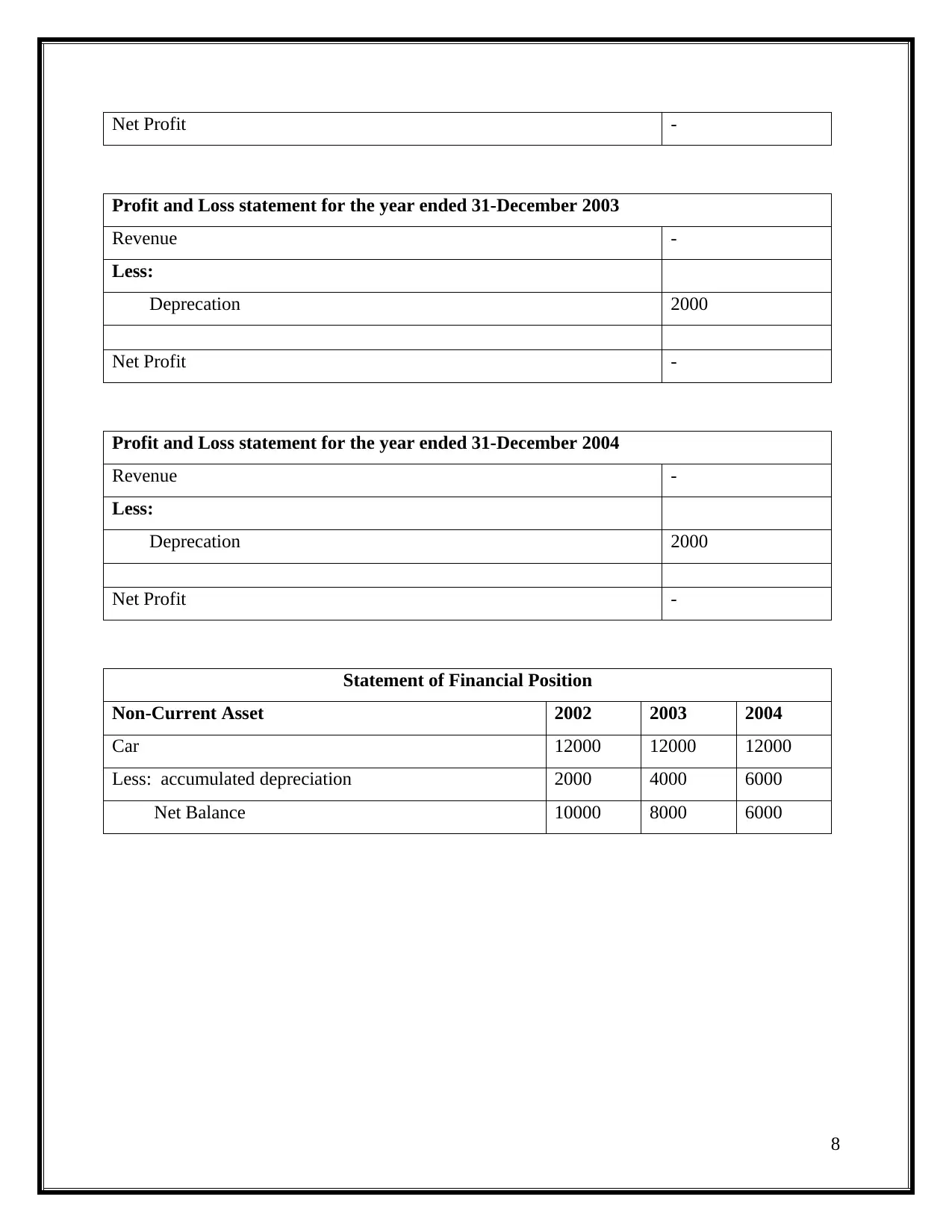
Net Profit -
Profit and Loss statement for the year ended 31-December 2003
Revenue -
Less:
Deprecation 2000
Net Profit -
Profit and Loss statement for the year ended 31-December 2004
Revenue -
Less:
Deprecation 2000
Net Profit -
Statement of Financial Position
Non-Current Asset 2002 2003 2004
Car 12000 12000 12000
Less: accumulated depreciation 2000 4000 6000
Net Balance 10000 8000 6000
8
Profit and Loss statement for the year ended 31-December 2003
Revenue -
Less:
Deprecation 2000
Net Profit -
Profit and Loss statement for the year ended 31-December 2004
Revenue -
Less:
Deprecation 2000
Net Profit -
Statement of Financial Position
Non-Current Asset 2002 2003 2004
Car 12000 12000 12000
Less: accumulated depreciation 2000 4000 6000
Net Balance 10000 8000 6000
8
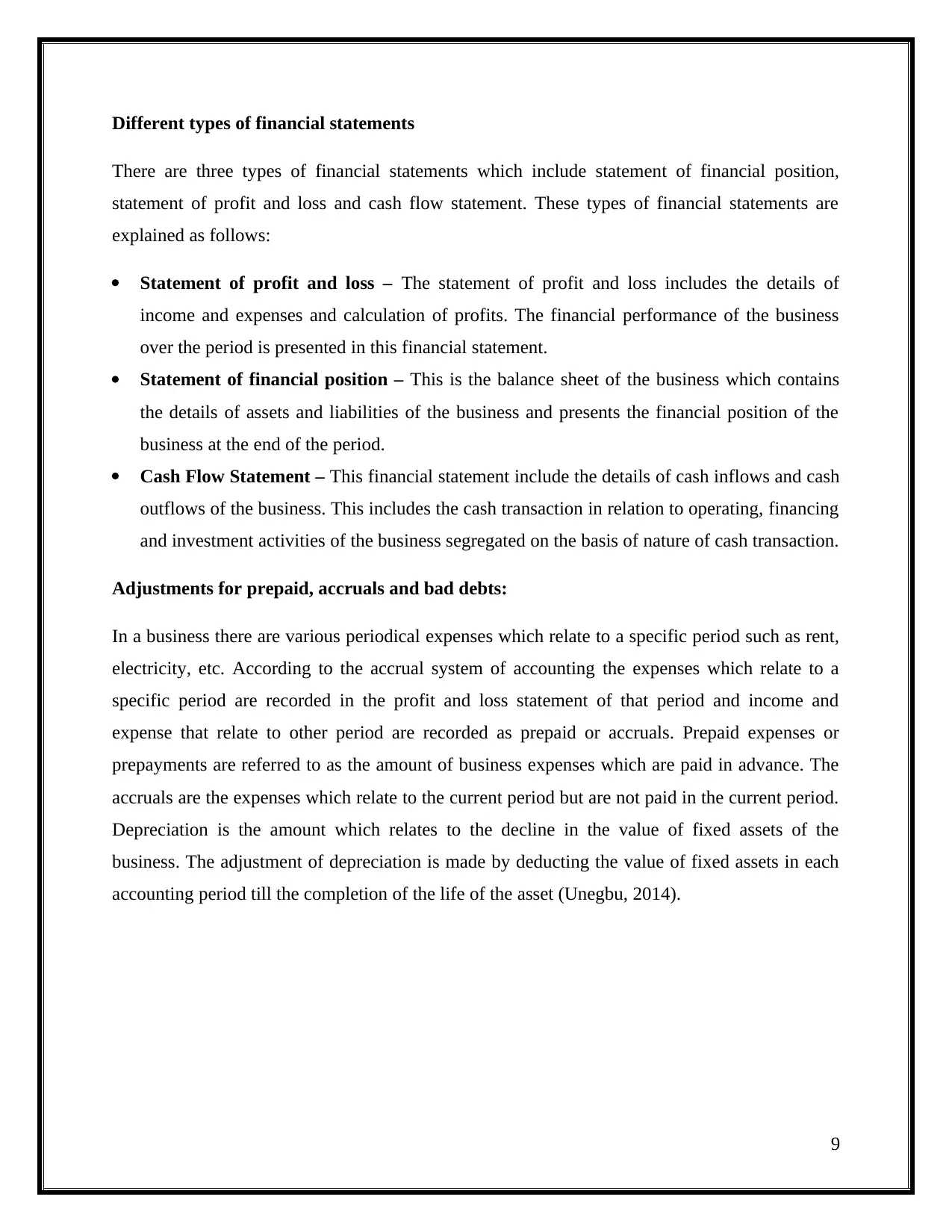
Different types of financial statements
There are three types of financial statements which include statement of financial position,
statement of profit and loss and cash flow statement. These types of financial statements are
explained as follows:
Statement of profit and loss – The statement of profit and loss includes the details of
income and expenses and calculation of profits. The financial performance of the business
over the period is presented in this financial statement.
Statement of financial position – This is the balance sheet of the business which contains
the details of assets and liabilities of the business and presents the financial position of the
business at the end of the period.
Cash Flow Statement – This financial statement include the details of cash inflows and cash
outflows of the business. This includes the cash transaction in relation to operating, financing
and investment activities of the business segregated on the basis of nature of cash transaction.
Adjustments for prepaid, accruals and bad debts:
In a business there are various periodical expenses which relate to a specific period such as rent,
electricity, etc. According to the accrual system of accounting the expenses which relate to a
specific period are recorded in the profit and loss statement of that period and income and
expense that relate to other period are recorded as prepaid or accruals. Prepaid expenses or
prepayments are referred to as the amount of business expenses which are paid in advance. The
accruals are the expenses which relate to the current period but are not paid in the current period.
Depreciation is the amount which relates to the decline in the value of fixed assets of the
business. The adjustment of depreciation is made by deducting the value of fixed assets in each
accounting period till the completion of the life of the asset (Unegbu, 2014).
9
There are three types of financial statements which include statement of financial position,
statement of profit and loss and cash flow statement. These types of financial statements are
explained as follows:
Statement of profit and loss – The statement of profit and loss includes the details of
income and expenses and calculation of profits. The financial performance of the business
over the period is presented in this financial statement.
Statement of financial position – This is the balance sheet of the business which contains
the details of assets and liabilities of the business and presents the financial position of the
business at the end of the period.
Cash Flow Statement – This financial statement include the details of cash inflows and cash
outflows of the business. This includes the cash transaction in relation to operating, financing
and investment activities of the business segregated on the basis of nature of cash transaction.
Adjustments for prepaid, accruals and bad debts:
In a business there are various periodical expenses which relate to a specific period such as rent,
electricity, etc. According to the accrual system of accounting the expenses which relate to a
specific period are recorded in the profit and loss statement of that period and income and
expense that relate to other period are recorded as prepaid or accruals. Prepaid expenses or
prepayments are referred to as the amount of business expenses which are paid in advance. The
accruals are the expenses which relate to the current period but are not paid in the current period.
Depreciation is the amount which relates to the decline in the value of fixed assets of the
business. The adjustment of depreciation is made by deducting the value of fixed assets in each
accounting period till the completion of the life of the asset (Unegbu, 2014).
9
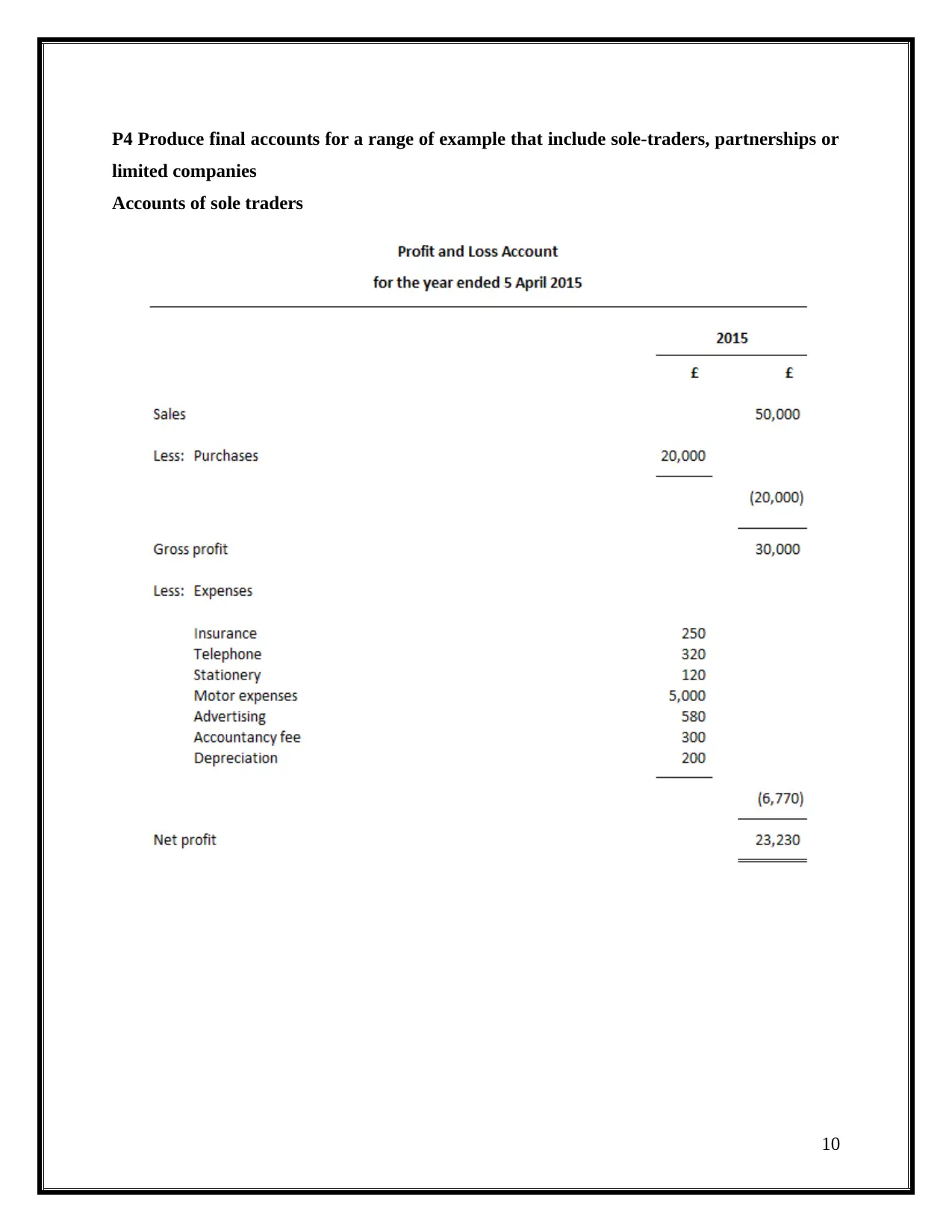
P4 Produce final accounts for a range of example that include sole-traders, partnerships or
limited companies
Accounts of sole traders
10
limited companies
Accounts of sole traders
10
Secure Best Marks with AI Grader
Need help grading? Try our AI Grader for instant feedback on your assignments.
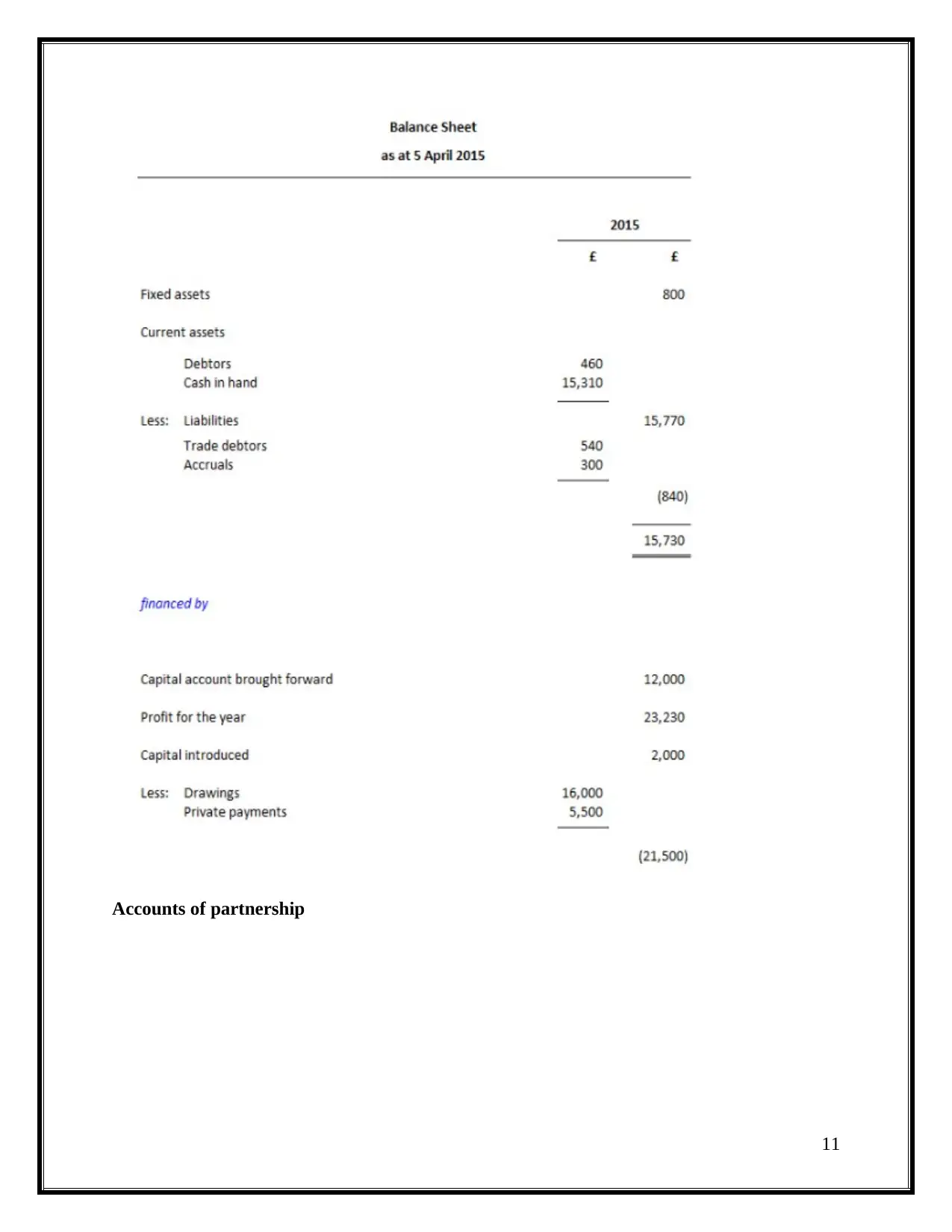
Accounts of partnership
11
11
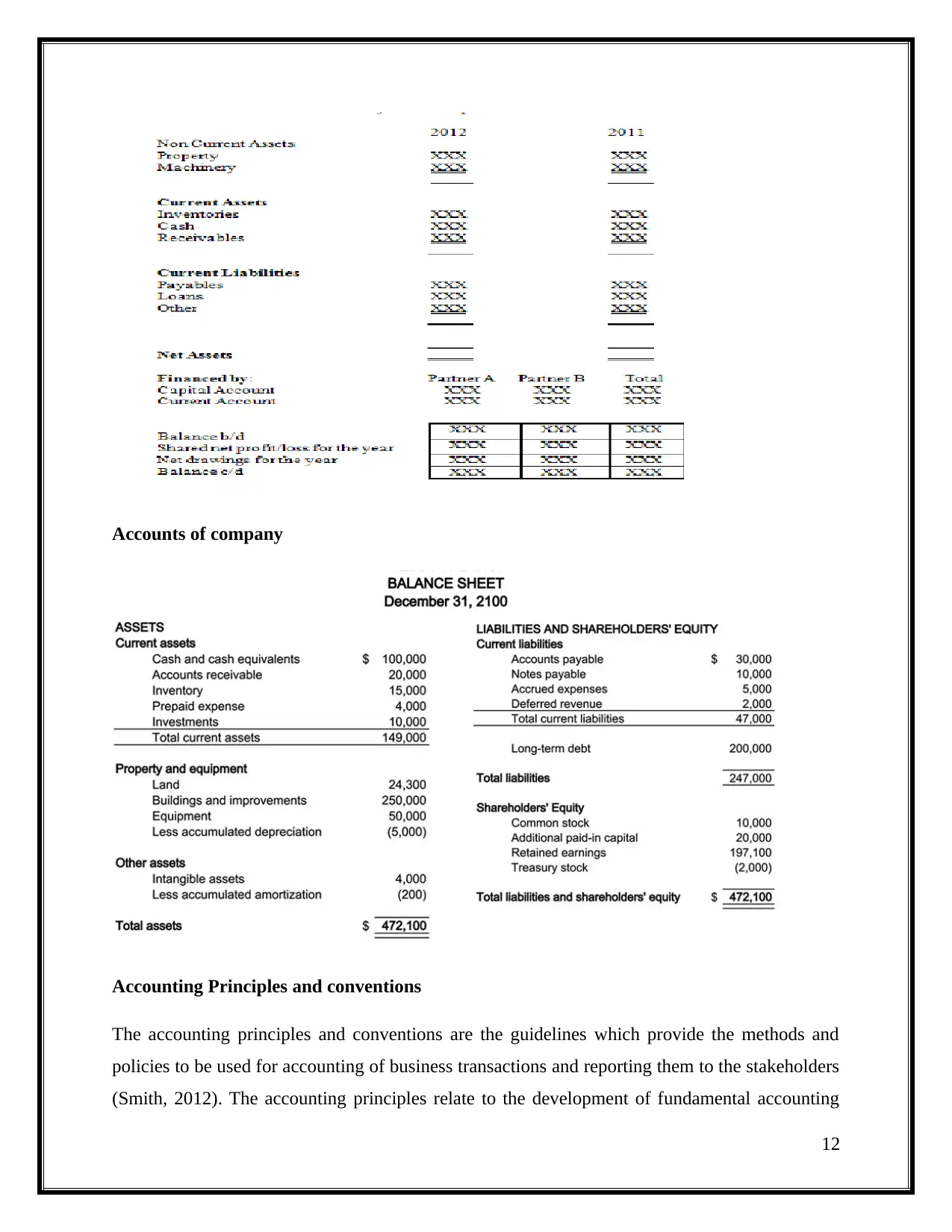
Accounts of company
Accounting Principles and conventions
The accounting principles and conventions are the guidelines which provide the methods and
policies to be used for accounting of business transactions and reporting them to the stakeholders
(Smith, 2012). The accounting principles relate to the development of fundamental accounting
12
Accounting Principles and conventions
The accounting principles and conventions are the guidelines which provide the methods and
policies to be used for accounting of business transactions and reporting them to the stakeholders
(Smith, 2012). The accounting principles relate to the development of fundamental accounting
12
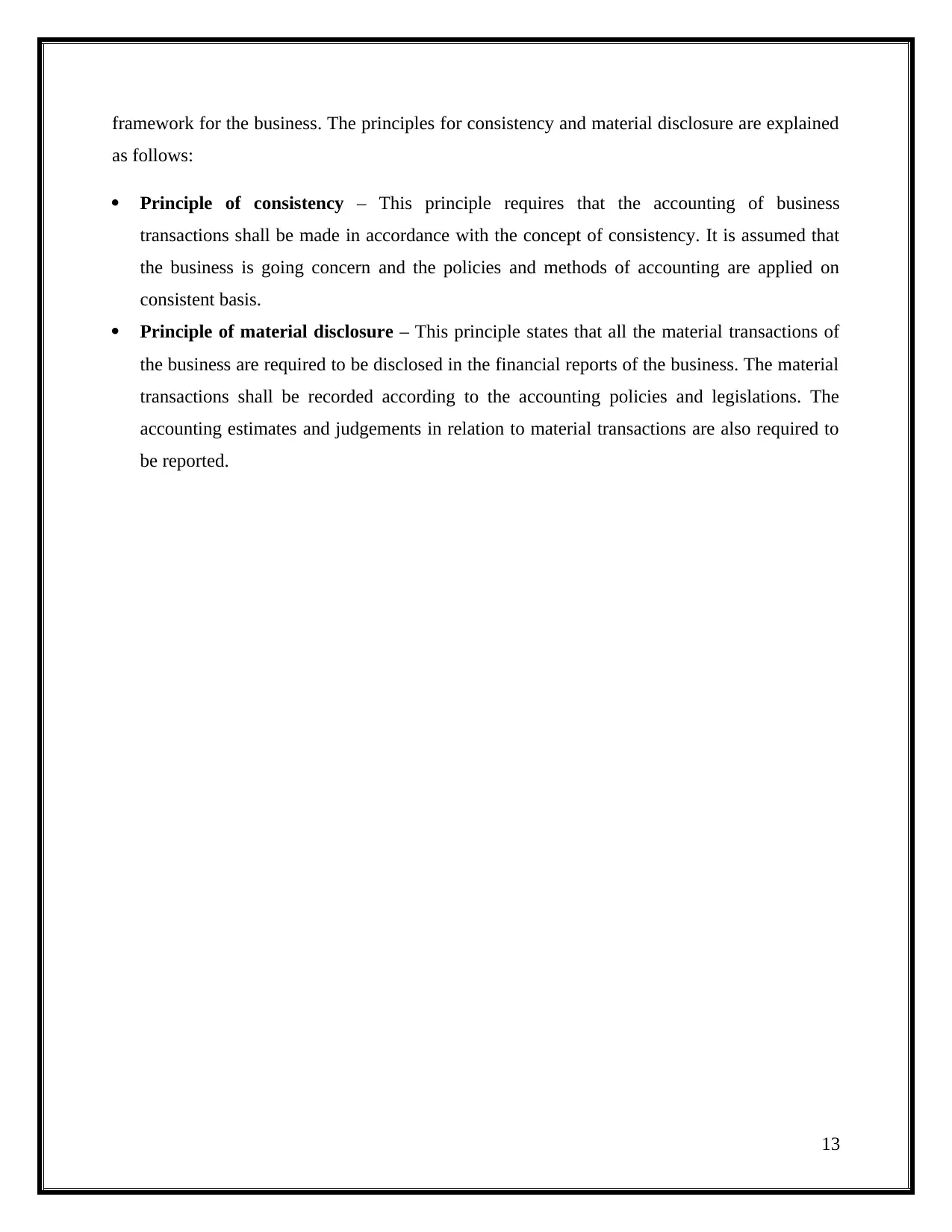
framework for the business. The principles for consistency and material disclosure are explained
as follows:
Principle of consistency – This principle requires that the accounting of business
transactions shall be made in accordance with the concept of consistency. It is assumed that
the business is going concern and the policies and methods of accounting are applied on
consistent basis.
Principle of material disclosure – This principle states that all the material transactions of
the business are required to be disclosed in the financial reports of the business. The material
transactions shall be recorded according to the accounting policies and legislations. The
accounting estimates and judgements in relation to material transactions are also required to
be reported.
13
as follows:
Principle of consistency – This principle requires that the accounting of business
transactions shall be made in accordance with the concept of consistency. It is assumed that
the business is going concern and the policies and methods of accounting are applied on
consistent basis.
Principle of material disclosure – This principle states that all the material transactions of
the business are required to be disclosed in the financial reports of the business. The material
transactions shall be recorded according to the accounting policies and legislations. The
accounting estimates and judgements in relation to material transactions are also required to
be reported.
13
Paraphrase This Document
Need a fresh take? Get an instant paraphrase of this document with our AI Paraphraser

Task 3:
P5: Apply the bank reconciliation process to prepare a number of bank reconciliations
Bank reconciliation statement
Particulars Amount £
Balance of Cash Book At 31-12-2017 11820
ADD:
Extra Amount recorded 900
Un-presented Cheques 6500
LESS:
Bank Charges 20
Dishonoured Cheque 200
Rent Received but Recorded in bank book 4000
Balance As per Pass book 15000
Bank reconciliation
Bank reconciliation is the method of matching the amount of accounting records with the
corresponding bank statement. This process is done to ascertain the differences between the two,
and if there is any differences then change the accounting records appropriately (Knowles, et.al,
2012). Bank reconciliation detect the fraud, ensures that the company cash record is maintain
correctly or not. This statement helps in ensuring the payments and cash collection id deposited
into the bank.
Why it is required or necessary?
Bank reconciliation is required in the company to compare the accounting records to those with
the bank. To ascertain whether the amount recorded of cash in the balance sheet is correct.
Mostly companies used double entry accounting so this statement helps to find out any error or
omission in cash account. The company requires maintaining this account as it improves the
internal control over the company cash. It is necessary to prepare the bank reconciliation before
the financial statements because it produces the accurate records of accounting and recognize
any mistake and fraud.
Who would be interested in the outcome of reconciliation?
14
P5: Apply the bank reconciliation process to prepare a number of bank reconciliations
Bank reconciliation statement
Particulars Amount £
Balance of Cash Book At 31-12-2017 11820
ADD:
Extra Amount recorded 900
Un-presented Cheques 6500
LESS:
Bank Charges 20
Dishonoured Cheque 200
Rent Received but Recorded in bank book 4000
Balance As per Pass book 15000
Bank reconciliation
Bank reconciliation is the method of matching the amount of accounting records with the
corresponding bank statement. This process is done to ascertain the differences between the two,
and if there is any differences then change the accounting records appropriately (Knowles, et.al,
2012). Bank reconciliation detect the fraud, ensures that the company cash record is maintain
correctly or not. This statement helps in ensuring the payments and cash collection id deposited
into the bank.
Why it is required or necessary?
Bank reconciliation is required in the company to compare the accounting records to those with
the bank. To ascertain whether the amount recorded of cash in the balance sheet is correct.
Mostly companies used double entry accounting so this statement helps to find out any error or
omission in cash account. The company requires maintaining this account as it improves the
internal control over the company cash. It is necessary to prepare the bank reconciliation before
the financial statements because it produces the accurate records of accounting and recognize
any mistake and fraud.
Who would be interested in the outcome of reconciliation?
14

The accountant prepares the bank reconciliation system. In company, the cashier, manager and
accountant re interested in the outcome of reconciliation.
Identifying variances through a bank reconciliation
Cheque issued in the company but not presented for the payment in the bank
Interest allowed by the bank but not recorded in the cash book
Cheque issued but returned on some technical ground
Cheque deposited by the company but not cleared by the bank
Bank charges
Cheque dishonoured
Amount wrongly credited by the bank
If the payment is done directly by the bank to the vendor and it is not recorded in the cash
book
Positive or negative impact on these variances:
Every variance may have higher or lower impact on the company. If the cheque is issued but not
presented for the payment then it will have a higher impact in the pass book. The variances occur
due to entries have been made in cash book but it is not recorded in the pass book or vice versa.
Cheque deposited by the company but not cleared by the bank would have a negative impact on
the company as it lowers the amount in the pass book. Amount wrongly credited by bank will
also have a positive impact as it will increase the balance in the pass book. Bank charges have
the negative impact as it decreases the amount. Amount wrongly debited or credited also have
positive or negative impact in the company as it increases or decreases the bank balance.
15
accountant re interested in the outcome of reconciliation.
Identifying variances through a bank reconciliation
Cheque issued in the company but not presented for the payment in the bank
Interest allowed by the bank but not recorded in the cash book
Cheque issued but returned on some technical ground
Cheque deposited by the company but not cleared by the bank
Bank charges
Cheque dishonoured
Amount wrongly credited by the bank
If the payment is done directly by the bank to the vendor and it is not recorded in the cash
book
Positive or negative impact on these variances:
Every variance may have higher or lower impact on the company. If the cheque is issued but not
presented for the payment then it will have a higher impact in the pass book. The variances occur
due to entries have been made in cash book but it is not recorded in the pass book or vice versa.
Cheque deposited by the company but not cleared by the bank would have a negative impact on
the company as it lowers the amount in the pass book. Amount wrongly credited by bank will
also have a positive impact as it will increase the balance in the pass book. Bank charges have
the negative impact as it decreases the amount. Amount wrongly debited or credited also have
positive or negative impact in the company as it increases or decreases the bank balance.
15
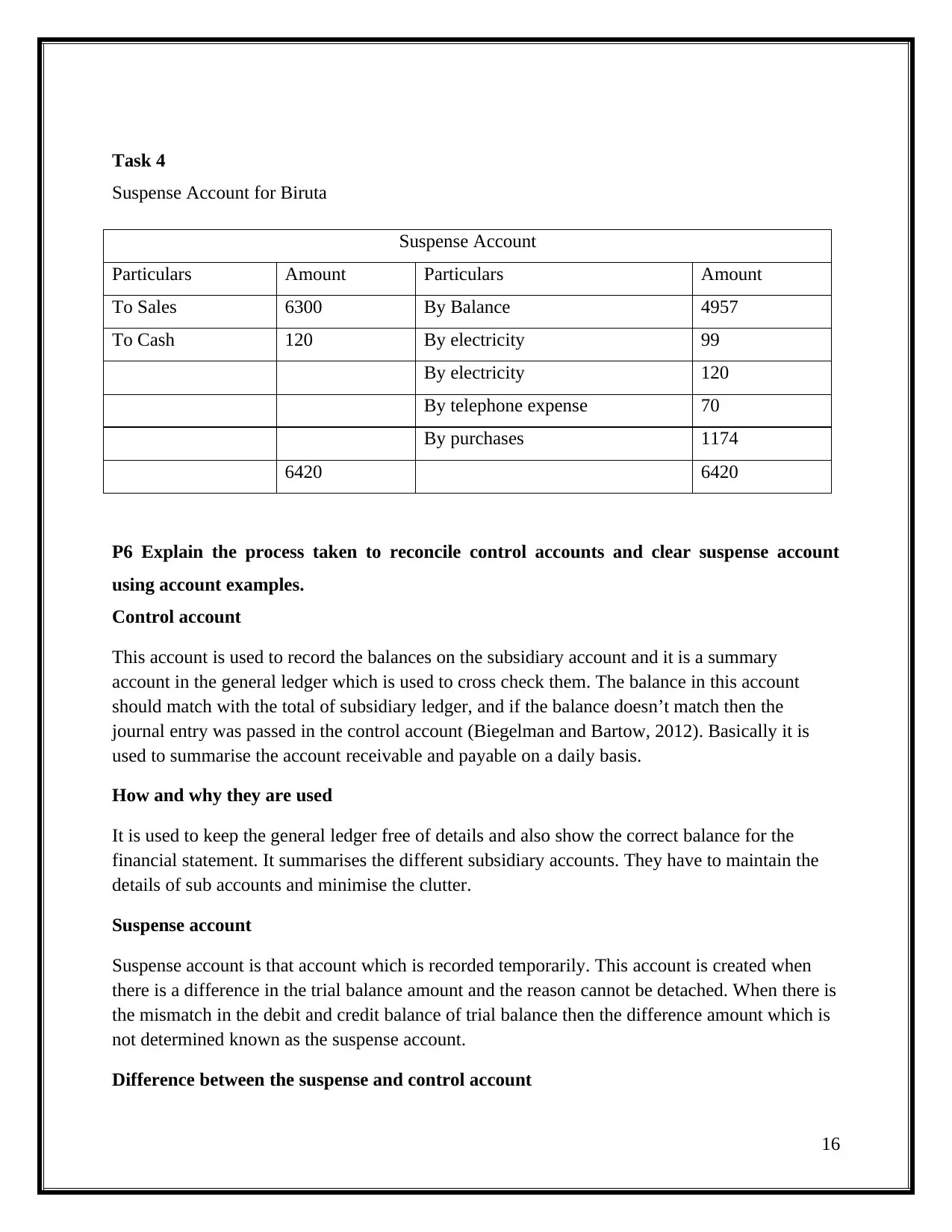
Task 4
Suspense Account for Biruta
Suspense Account
Particulars Amount Particulars Amount
To Sales 6300 By Balance 4957
To Cash 120 By electricity 99
By electricity 120
By telephone expense 70
By purchases 1174
6420 6420
P6 Explain the process taken to reconcile control accounts and clear suspense account
using account examples.
Control account
This account is used to record the balances on the subsidiary account and it is a summary
account in the general ledger which is used to cross check them. The balance in this account
should match with the total of subsidiary ledger, and if the balance doesn’t match then the
journal entry was passed in the control account (Biegelman and Bartow, 2012). Basically it is
used to summarise the account receivable and payable on a daily basis.
How and why they are used
It is used to keep the general ledger free of details and also show the correct balance for the
financial statement. It summarises the different subsidiary accounts. They have to maintain the
details of sub accounts and minimise the clutter.
Suspense account
Suspense account is that account which is recorded temporarily. This account is created when
there is a difference in the trial balance amount and the reason cannot be detached. When there is
the mismatch in the debit and credit balance of trial balance then the difference amount which is
not determined known as the suspense account.
Difference between the suspense and control account
16
Suspense Account for Biruta
Suspense Account
Particulars Amount Particulars Amount
To Sales 6300 By Balance 4957
To Cash 120 By electricity 99
By electricity 120
By telephone expense 70
By purchases 1174
6420 6420
P6 Explain the process taken to reconcile control accounts and clear suspense account
using account examples.
Control account
This account is used to record the balances on the subsidiary account and it is a summary
account in the general ledger which is used to cross check them. The balance in this account
should match with the total of subsidiary ledger, and if the balance doesn’t match then the
journal entry was passed in the control account (Biegelman and Bartow, 2012). Basically it is
used to summarise the account receivable and payable on a daily basis.
How and why they are used
It is used to keep the general ledger free of details and also show the correct balance for the
financial statement. It summarises the different subsidiary accounts. They have to maintain the
details of sub accounts and minimise the clutter.
Suspense account
Suspense account is that account which is recorded temporarily. This account is created when
there is a difference in the trial balance amount and the reason cannot be detached. When there is
the mismatch in the debit and credit balance of trial balance then the difference amount which is
not determined known as the suspense account.
Difference between the suspense and control account
16
Secure Best Marks with AI Grader
Need help grading? Try our AI Grader for instant feedback on your assignments.
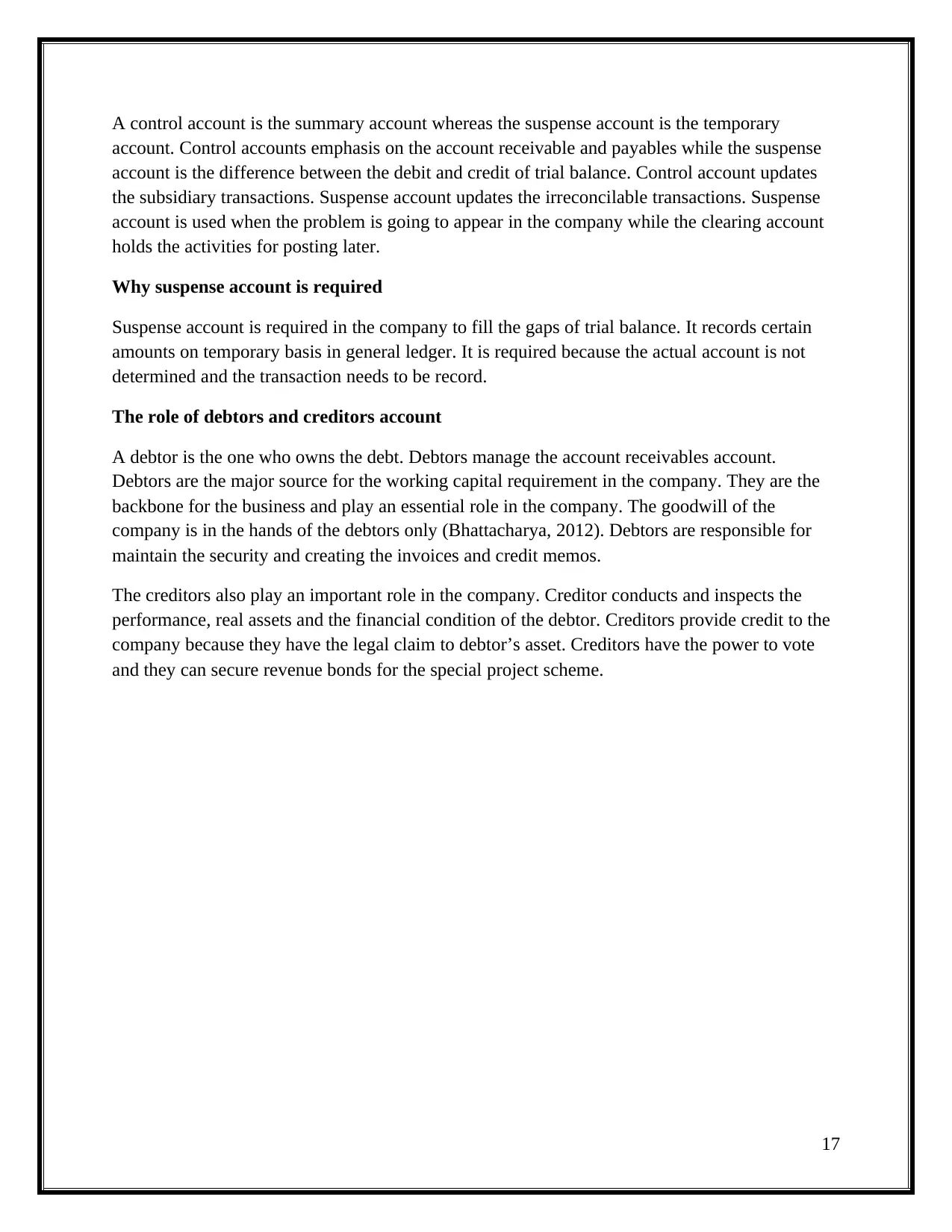
A control account is the summary account whereas the suspense account is the temporary
account. Control accounts emphasis on the account receivable and payables while the suspense
account is the difference between the debit and credit of trial balance. Control account updates
the subsidiary transactions. Suspense account updates the irreconcilable transactions. Suspense
account is used when the problem is going to appear in the company while the clearing account
holds the activities for posting later.
Why suspense account is required
Suspense account is required in the company to fill the gaps of trial balance. It records certain
amounts on temporary basis in general ledger. It is required because the actual account is not
determined and the transaction needs to be record.
The role of debtors and creditors account
A debtor is the one who owns the debt. Debtors manage the account receivables account.
Debtors are the major source for the working capital requirement in the company. They are the
backbone for the business and play an essential role in the company. The goodwill of the
company is in the hands of the debtors only (Bhattacharya, 2012). Debtors are responsible for
maintain the security and creating the invoices and credit memos.
The creditors also play an important role in the company. Creditor conducts and inspects the
performance, real assets and the financial condition of the debtor. Creditors provide credit to the
company because they have the legal claim to debtor’s asset. Creditors have the power to vote
and they can secure revenue bonds for the special project scheme.
17
account. Control accounts emphasis on the account receivable and payables while the suspense
account is the difference between the debit and credit of trial balance. Control account updates
the subsidiary transactions. Suspense account updates the irreconcilable transactions. Suspense
account is used when the problem is going to appear in the company while the clearing account
holds the activities for posting later.
Why suspense account is required
Suspense account is required in the company to fill the gaps of trial balance. It records certain
amounts on temporary basis in general ledger. It is required because the actual account is not
determined and the transaction needs to be record.
The role of debtors and creditors account
A debtor is the one who owns the debt. Debtors manage the account receivables account.
Debtors are the major source for the working capital requirement in the company. They are the
backbone for the business and play an essential role in the company. The goodwill of the
company is in the hands of the debtors only (Bhattacharya, 2012). Debtors are responsible for
maintain the security and creating the invoices and credit memos.
The creditors also play an important role in the company. Creditor conducts and inspects the
performance, real assets and the financial condition of the debtor. Creditors provide credit to the
company because they have the legal claim to debtor’s asset. Creditors have the power to vote
and they can secure revenue bonds for the special project scheme.
17
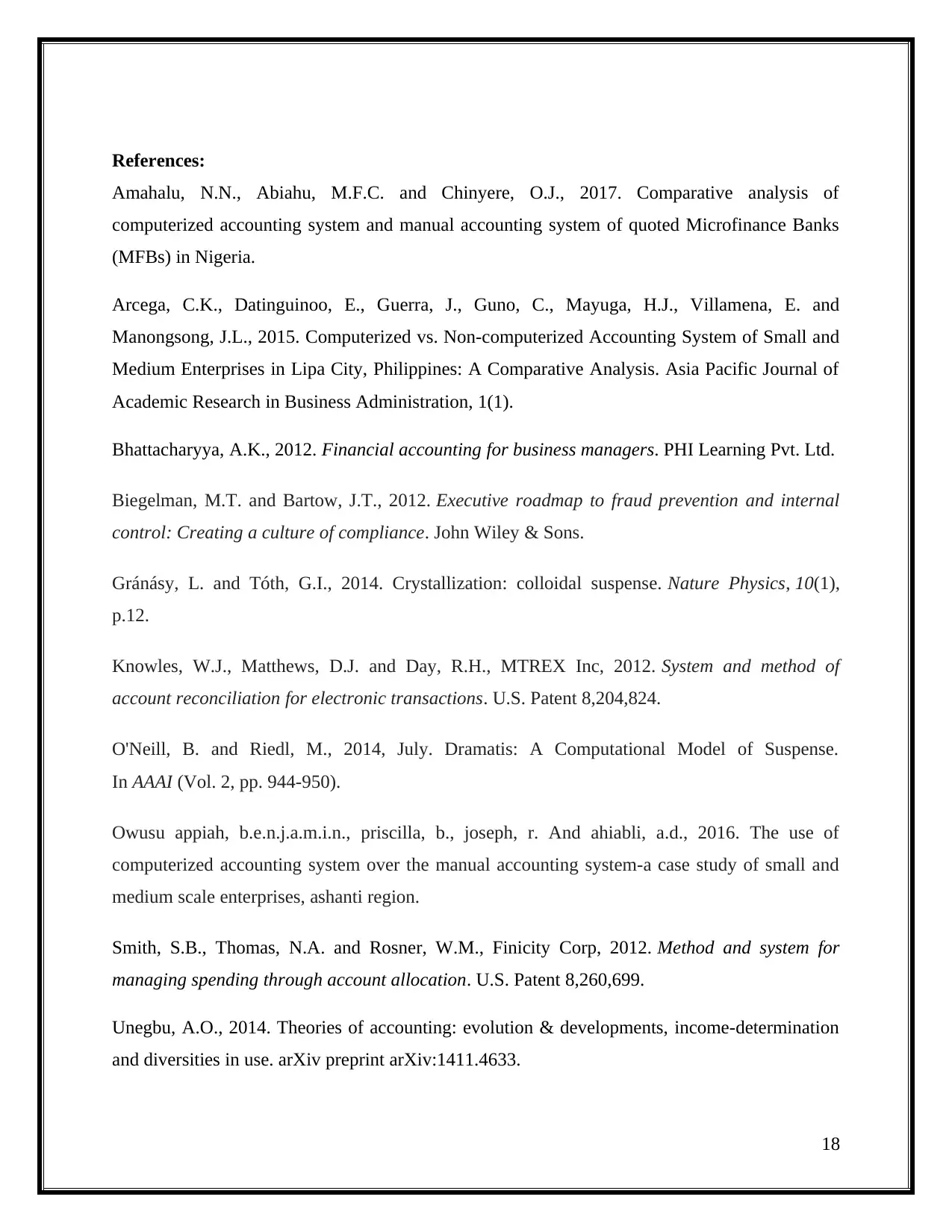
References:
Amahalu, N.N., Abiahu, M.F.C. and Chinyere, O.J., 2017. Comparative analysis of
computerized accounting system and manual accounting system of quoted Microfinance Banks
(MFBs) in Nigeria.
Arcega, C.K., Datinguinoo, E., Guerra, J., Guno, C., Mayuga, H.J., Villamena, E. and
Manongsong, J.L., 2015. Computerized vs. Non-computerized Accounting System of Small and
Medium Enterprises in Lipa City, Philippines: A Comparative Analysis. Asia Pacific Journal of
Academic Research in Business Administration, 1(1).
Bhattacharyya, A.K., 2012. Financial accounting for business managers. PHI Learning Pvt. Ltd.
Biegelman, M.T. and Bartow, J.T., 2012. Executive roadmap to fraud prevention and internal
control: Creating a culture of compliance. John Wiley & Sons.
Gránásy, L. and Tóth, G.I., 2014. Crystallization: colloidal suspense. Nature Physics, 10(1),
p.12.
Knowles, W.J., Matthews, D.J. and Day, R.H., MTREX Inc, 2012. System and method of
account reconciliation for electronic transactions. U.S. Patent 8,204,824.
O'Neill, B. and Riedl, M., 2014, July. Dramatis: A Computational Model of Suspense.
In AAAI (Vol. 2, pp. 944-950).
Owusu appiah, b.e.n.j.a.m.i.n., priscilla, b., joseph, r. And ahiabli, a.d., 2016. The use of
computerized accounting system over the manual accounting system-a case study of small and
medium scale enterprises, ashanti region.
Smith, S.B., Thomas, N.A. and Rosner, W.M., Finicity Corp, 2012. Method and system for
managing spending through account allocation. U.S. Patent 8,260,699.
Unegbu, A.O., 2014. Theories of accounting: evolution & developments, income-determination
and diversities in use. arXiv preprint arXiv:1411.4633.
18
Amahalu, N.N., Abiahu, M.F.C. and Chinyere, O.J., 2017. Comparative analysis of
computerized accounting system and manual accounting system of quoted Microfinance Banks
(MFBs) in Nigeria.
Arcega, C.K., Datinguinoo, E., Guerra, J., Guno, C., Mayuga, H.J., Villamena, E. and
Manongsong, J.L., 2015. Computerized vs. Non-computerized Accounting System of Small and
Medium Enterprises in Lipa City, Philippines: A Comparative Analysis. Asia Pacific Journal of
Academic Research in Business Administration, 1(1).
Bhattacharyya, A.K., 2012. Financial accounting for business managers. PHI Learning Pvt. Ltd.
Biegelman, M.T. and Bartow, J.T., 2012. Executive roadmap to fraud prevention and internal
control: Creating a culture of compliance. John Wiley & Sons.
Gránásy, L. and Tóth, G.I., 2014. Crystallization: colloidal suspense. Nature Physics, 10(1),
p.12.
Knowles, W.J., Matthews, D.J. and Day, R.H., MTREX Inc, 2012. System and method of
account reconciliation for electronic transactions. U.S. Patent 8,204,824.
O'Neill, B. and Riedl, M., 2014, July. Dramatis: A Computational Model of Suspense.
In AAAI (Vol. 2, pp. 944-950).
Owusu appiah, b.e.n.j.a.m.i.n., priscilla, b., joseph, r. And ahiabli, a.d., 2016. The use of
computerized accounting system over the manual accounting system-a case study of small and
medium scale enterprises, ashanti region.
Smith, S.B., Thomas, N.A. and Rosner, W.M., Finicity Corp, 2012. Method and system for
managing spending through account allocation. U.S. Patent 8,260,699.
Unegbu, A.O., 2014. Theories of accounting: evolution & developments, income-determination
and diversities in use. arXiv preprint arXiv:1411.4633.
18
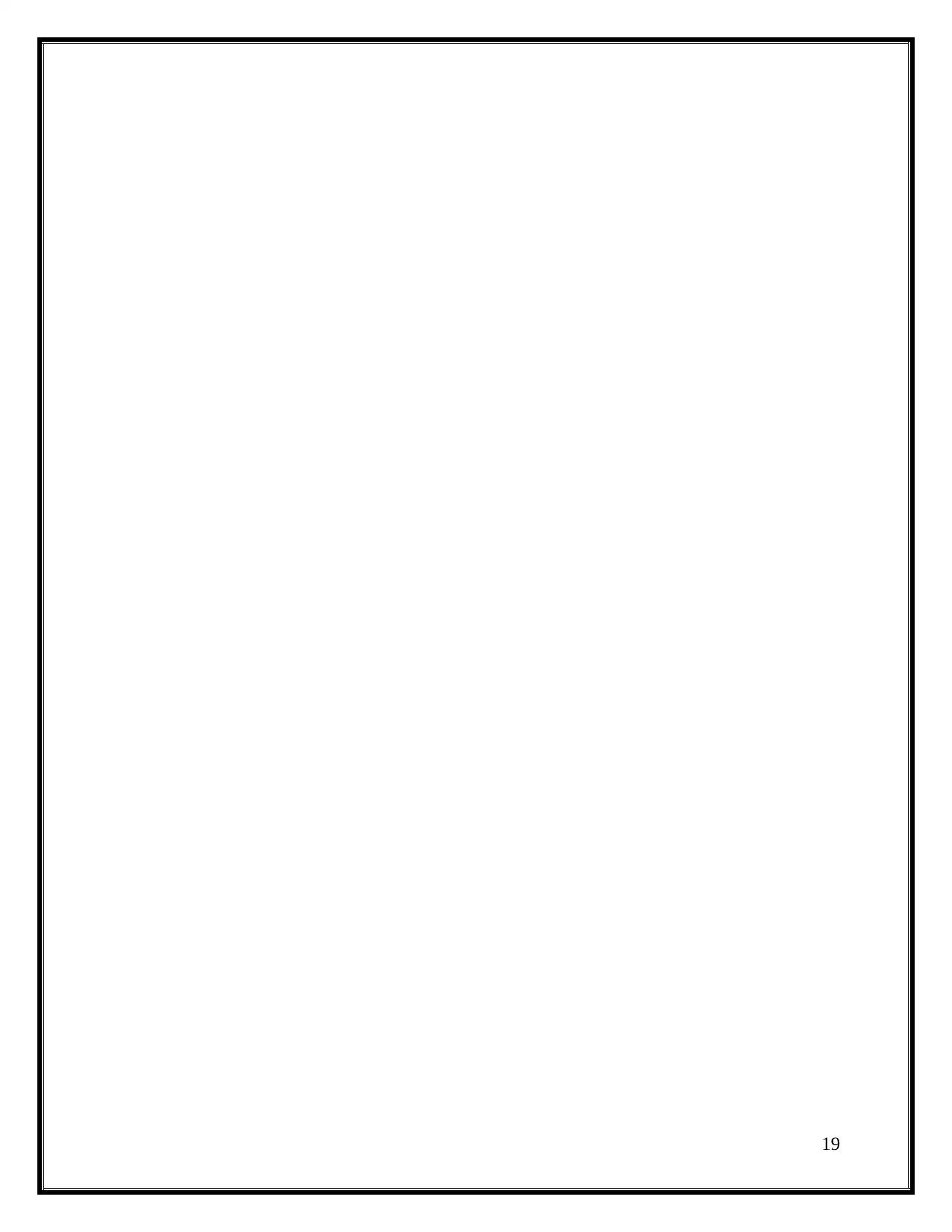
19
1 out of 19
Related Documents
Your All-in-One AI-Powered Toolkit for Academic Success.
+13062052269
info@desklib.com
Available 24*7 on WhatsApp / Email
![[object Object]](/_next/static/media/star-bottom.7253800d.svg)
Unlock your academic potential
© 2024 | Zucol Services PVT LTD | All rights reserved.





